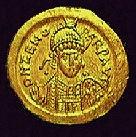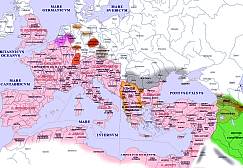Roman Emperors Dir Zeno
An Online Encyclopedia of Roman Emperors
Zeno (AD 474-491)
Hugh Elton

Zeno was from Isauria where he bore the name Tarasicodissa. His mother's name was Lallis, and either his father or his home village was called Rusumblada. He had a military career under Leo and is first heard of in 466, bringing evidence to court which showed the treachery of Ardabur, the son of the magister militum Aspar. After this he married Ariadne, Leo's eldest daughter, and changed his name to Zeno. Their son, Leo II, reigned briefly with Leo I in 473-4 and then alone for three weeks before making Zeno co-Augustus from 9 February, 474. After Leo's death from illness on November 17 (?) 474, Zeno reigned alone. A second son, Zeno, died before the end of Zeno's reign. Zeno died on 9 April 491 and was succeeded by Anastasius.
Zeno was frequently unpopular during his reign, in part because of his Isaurian origins, though financial difficulties did not help. In part these were the consequences of Leo's disastrous Vandal expedition, but one of Zeno's solutions, selling offices systematically, did not make him popular with the aristocracy. Nor did it help that Zeno himself was impressed by astrologers and executed the silentarius Pelagius in 490 on the basis of a prediction that he would succeed as emperor. Despite several revolts and usurpations and severe foreign problems, he was able to remain in power for seventeen years and to die in peace.
In January 475, less than three months after his sole rule began, Zeno was faced by a conspiracy of Verina (Leo's wife) and her brother Basiliscus, supported by the Isaurian Illus and the Goth Theoderic Strabo. Zeno fled from the capital and Basiliscus was declared emperor, ruling for a year in 475-6. When Zeno fled to Isauria, Basiliscus sent an army against him led by Illus. Illus laid siege to Zeno, but when Basiliscus failed to keep his promises to Illus, Illus helped restore Zeno to power in August 476. While in exile, Zeno continued to mint coins at Antioch.
In 478, Verina, Zeno's mother-in-law, upset at Illus' betrayal of her brother, Basiliscus, promoted an attempt on Illus' life. When she was caught, Zeno turned her over to Illus who imprisoned her in Isauria. But even in prison, Verina continued to act against Zeno, encouraging her other son-in-law Marcian to revolt in 479, a revolt swiftly and decisively quashed by Illus. Marcian was supported by the Goth Theoderic Strabo. Ariadne, Verina's daughter and Zeno's wife, wanted her mother out of prison, so she too tried to have Illus killed. The failure of this attempt led Zeno to move Illus from Constantinople to Antioch and to promote him to magister militum per Orientem.
In 482 Zeno, in an attempt to mediate between the Chalcedonians and Monophysites, issued a religious statement, the Henotikon. This provoked widespread opposition among the extreme bishops of the eastern empire, especially the patriarchs of Antioch and Alexandria, though was popular with the moderates. The moderation, however, led Pope Felix III to excommunicate Acacius, Patriarch of Constantinople, causing a schism with the West.
In 483 Illus was asked to release Longinus, Zeno's brother whom he had taken hostage. When Illus refused to do this, he was dismissed. He rebelled in 484 and Zeno sent another Isaurian, Leontius, against him. Illus persuaded Leontius to desert Zeno and then, with the support of Verina, declared Leontius Augustus. Another general, Ioannes the Scythian, led another army east, and rapidly defeated Illus at Antioch in Syria. Illus was then besieged at Papirius in Isauria. Verina died in the first year of the siege. The fortress was betrayed in 488 and Leontius and Illus were executed.
Zeno's interests in the West were minimal, in part because the other problems he faced were so severe. Initial raids by the Vandals were dealt with by negotiation. In 474 Zeno declared Nepos western Emperor in Italy, though by August 475 Nepos had been replaced and forced into Dalmatia. Zeno continued to recognize Nepos as emperor down to his death in 480, then accepted Odoacer as patricius. In the Balkans, down to 481, when Theoderic Strabo died in an accident, Zeno was able to play off the two Gothic groups of Theoderic Strabo and Theoderic the Amal against one another. After 481, Theoderic the Amal proved dangerous until 488, when Zeno sent him against Odoacer in Italy, removing the main independent Gothic body in the Balkans. During Zeno's reign there was a danger of conflict with the Persians, though this was avoided.
Bibliography
For references to primary sources, see entries in RE or the PRLE. Translations of much of the source material can be found here in Ralph Mathisen's DIR essays on the "Shadow Emperors", or in C.D. Gordon ( The Age of Attila: Fifth-Century Byzantium and the Barbarians [Ann Arbor, 1960]) and R.C. Blockley (Fragmentary Classicizing Historians of the Later Roman Empire [Liverpool, 1983], vol. 2.).
Brooks, E.W., "The Emperor Zenon and the Isaurians", EHR 8 (1893): 209-238.
Burgess, W.D., "Isaurian Factions in the Reign of Zeno the Isaurian", Latomus 51 (1992): 874-880.
Heather, P.J., Goths and Romans (Oxford, 1991).
Kent, J.P.C., Roman Imperial Coinage volume 10 (London, 1994), 109-121.
Laniado, A., "Some problems in the sources for the reign of the emperor Zeno", BMGS 15 (1991): 147-173.
Lippold, A., RE 10 A (1972), 149-213.
McCormick, M., "Odoacer, emperor Zeno and the Rugian Victory Legation", Byzantion 47 (1977): 212-222.
Pingree, D., "Political Horoscopes from the Reign of Zeno", DOP 30 (1976), 133-150.
Prosopography of the Later Roman Empire, vol. 2, ed. J.R. Martindale (Cambridge, 1980)
on name, see Feissel, D., "Notes d'Épigraphie chrétienne (VIII)", BCH 108 (1984): 564-6, n.105; supplanting Harrison, M., "The Emperor Zeno's Real Name", BZ 74 (1981): 27-28.
Copyright (C), Hugh Elton. This file may be copied on the condition that the entire contents, including the header and this copyright notice, remain intact.
For more detailed geographical information, please use the DIR/ORBAntique and Medieval Atlas below. Click on the appropriate part of the map below to access large area maps.

 DIR Atlas
DIR Atlas